This article was published June 2002 on the website of Pekiti Tirsia Europe:

Pekiti Tirsia and the Military

If you look around the martial arts and combat sports scene, you will quickly find two very different training methods: There are the hierarchical, military-style systems whose teachings are based on command and obedience, designed to teach a large group of students in a uniform manner. Then there are the family-like systems that teach a small number of people according to their personal knowledge and individual abilities.
Following the above classification, Pekiti Tirsia Kali clearly falls into the category of family oriented systems: First, Pekiti Tirsia Kali is the martial art of the Tortal family, represented by Grand Tuhon Leo T. Gaje. Secondly, some of the characteristics for the teaching process of the Pekiti Tirsia system are the family-like, personal and relaxed atmosphere that Grand Tuhon creates and the way he responds to the peculiarities of each individual. However, in recent years the Pekiti Tirsia system has been mentioned more and more often in connection with military commando units and special forces. Why is that?
Importance of Close Quarter Combat for the Military

The importance of close combat to the military has changed over time. In the last major wars in Europe, battles were no longer decided by close combat tactics. Modern weaponry has made it relatively simple to kill from a distance, reducing the value of investing a significant portion of training on the survival of individual soldier. In the context of war, individual soldiers became replaceable.
The primary objective of military training became to instill discipline in soldiers. However, this discipline is not meant to be at the individual level, but rather to foster a sense of belonging to a group and to follow the orders of a superior. In line with this, only those martial arts training methods were deemed suitable for military mass training that enabled soldiers to be drilled in disciplined obedience to commands. Many of the martial arts in Europe and the USA (especially those of Japanese or Korean origin) have their roots in military branches and often this origin is easily recognisable in the training.
Today: Guerrilla-Problem of the Military
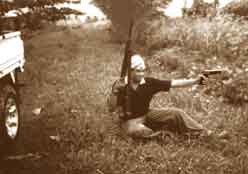
Recent events have demonstrated that the majority of contemporary wars and military conflicts are no longer decided by large numbers of infantry soldiers. The media coverage of the Gulf War and the military operations in Kosovo and Afghanistan has highlighted that modern armed forces are confronted with different situations and have to meet different requirements. In modern warfare, the opponent often utilises guerrilla tactics and can only be defeated by a good understanding of this type of warfare and the application of suitable methods.
The importance of guerrilla tactics was demonstrated by the Armed Forces of the Philippines. In the Second World War, Filipino warriors refused to back down after General MacArthur's withdrawal and continued to fight the Japanese invaders despite inferior weaponry. They showed great virtue and applied Kali strategies (Bolo Battalion), successfully delaying the advancement of the Japanese Army. This allowed the Americans to reorganise their war machinery at home and finally allowed them to successfully fight back the Japanese.
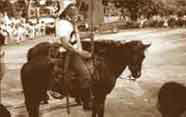
It is clear that the Filipino government has not learned its lesson about the importance of special forces units. Despite the fact that these World War II veterans are still celebrated as heroes in parades (see our Report about the Filipino Centennial) and that their contribution has also been acknowledged in the USA, the Filipino government has failed to recognise the value of these units. The Americans were quick to realise the importance of special forces units like the Delta Force and the Navy Seals. The Filipino Armed Forces (as many others did all over the world) continued to train and act according to the methods of the colonial army. This was perhaps because military elite units could have been considered a danger to democracy. However, until today, the encounters between the Armed Forces of the Philippines and the militant separatists in the south of the Philippines have shown that conventional military tactics are almost useless if used against guerrilla fighters.
The leaders of the Filipino Armed Forces understood this some years ago and made the decision to additionally train some of the special units in the strategies and tactics of the almost forgotten Filipino martial arts.
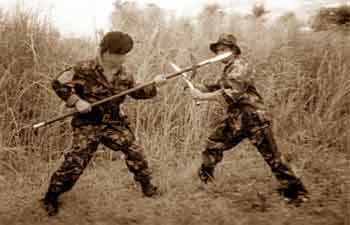
The first to grasp the situation and implement the programme were the Force Recon Marines. The Recon Marines, short for Force Reconnaissance, are experts in deep reconnaissance and direct action. They spend a significant portion of their missions in small teams in hostile territory. They can't rely on extensive air support. In combat, they have to stand on their own. The Recon Marines motto is "Swift, Silent - Deadly" or "Outnumbered - But Never Outfought". In the Philippines, the Force Recon are the most respected, admired and feared among the special units. (Information about the US Recon Marines can be found here: http://www.forcerecon.com/strongmenarmed.htm)
Solution: Pekiti Tirsia Kali

When the Recons Marines began searching for a Close Quarter Combat System, they received numerous applications from both within and outside the Philippines. Everyone wanted to be the one to train this highly esteemed unit.
The Recon Marines knew exactly what they wanted. With their extensive combat experience, they had a clear idea of what they were looking for, what they wanted and what they didn't want. They had a selection process, in which the applicants had to present themselves and their teaching programmes. The Pekiti Tirsia Kali system under the guidance of Grand Tuhon Leo T. Gaje was the only one to succeed. The Force Recon Marines chose to be trained in Pekiti Tirsia.
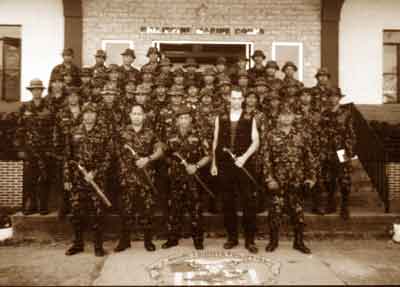
In January, I met Grand Tuhon in the Philippines. We visited the Armed Forces Philippines Central Command in Cebu. The training programme was a huge success, so much so that the leading officers didn't want us to leave. However, we have been scheduled to train the Force Recon marines and the present Special Forces from the USA in Cavite (This has been widely reported in the news. The USA Special Forces met with the Force Recon to prepare themselves for the operations to come in the south of the Philippines). It is clear that the US Special Forces have a strong interest in improving themselves in knife skills.
Grand Tuhon and his nephew Rommel Tortal participated as Close Quarter Combat Trainers (and probably as the only non-military trainers) at the combined US-Filipino military exercise BALIKATAN "shoulder to shoulder" 2002. For his achievements Grand Tuhon Gaje has been decorated with a medal and Grand Tuhon has been invited as trainer for the Special Forces to the US Base in Okinawa and Fort Bragg in the USA.
 The Recon Marines chose Pekiti Tirsia for a good reason. They were convinced by the combat methods, which are focused on blades and direct counter-attacks using the Pekiti Tirsia COMBAT (Counter On Motion Before Attack Time) principle.
The Recon Marines chose Pekiti Tirsia for a good reason. They were convinced by the combat methods, which are focused on blades and direct counter-attacks using the Pekiti Tirsia COMBAT (Counter On Motion Before Attack Time) principle.
However, my cross-training with the Recon Marines revealed another reason that is just as important. They chose Pekiti Tirsia because the Recon Marines and the Pekiti Tirsia people share the same philosophy. Training with the Recon Marines shows what attitude or philosophy somebody needs to have if they want to survive in extreme situations. Second place is not good enough; success is only in the team. The Force Recon Marines are known to be the best there is in what they are doing. Their training is a product of their mental attitude towards life.
What it means for us...
Today Pekiti Tirsia Kali is such a practical and realistic system, because Grand Tuhon and his ancestors tested and refined it in real life. Grand Tuhon says, Pekiti Tirsia Kali has been developed and tested in the laboratory of pain.
The same is true for the Recon Marines. Almost every day the Recon Marines risk their lives and prove anew the effectiveness of the Pekiti Tirsia strategies and tactics in close quarter combat. After every mission a debriefing session is held and experiences are exchanged. What did the Recon Marines experience? Where have been dangers or maybe casualties? How could these situations have been solved better? When these matters are discussed, the Pekiti Tirsia system is thoroughly checked and practical questions are answered. The Recon Marines risk their lives on every mission. If it comes to combat training, they would not lie to themselves for convenience or other reasons. The tradition of the Laboratory of Pain in the Pekiti Tirsia Kali is still on.
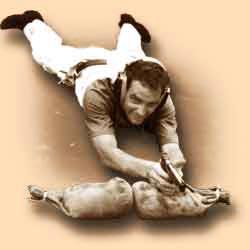
Of course the trainers who are in charge of teaching Pekiti Tirsia to the Recon Marines must be able to comprehend the situation and practical problems of the soldiers. Hence the Pekiti Tirsia trainers engage in cross-training with the Recon Marines. Survival in Jungle Environment, Combatant Swimming and Diving, Parachute Jumping, Mountaineering, Moving under Fire, Shooting while moving, Survival Resistance Evasion Escape, Snipering, and more is on the schedule. A one-of-a-kind opportunity for the Pekiti Tirsia instructors to benefit from the treasure of knowledge of this experts.
For Pekiti Tirsia it is good to know: The system has been successfully reality tested in the past, is being tested today, and will be tested again tomorrow. And even despite these very special circumstances, the core of our strategies and tactics remains unchanged. There is no doubt that the system is as up-to-date as ever before.
Discipline, Courage and Determination
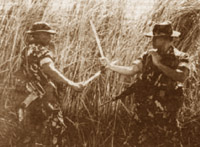 The Recon Marines learned to value Pekiti Tirsia, because our philosophy is quite similar to that of the Force Recon Marines. To believe in Success, Life and Good Health are essential for the Recon Marines as well. The Philosophy is the foundation for self-discipline, courage and determination. A Recon Marine can't afford a mistake. Because the Filipino Recon Marines have to rely more on their personal abilities (the quality of the man) than on advanced technology or quantity of soldiers, Pekiti Tirsia is the choice of this men. Because if you fight at the sharp end, the training is honest!
The Recon Marines learned to value Pekiti Tirsia, because our philosophy is quite similar to that of the Force Recon Marines. To believe in Success, Life and Good Health are essential for the Recon Marines as well. The Philosophy is the foundation for self-discipline, courage and determination. A Recon Marine can't afford a mistake. Because the Filipino Recon Marines have to rely more on their personal abilities (the quality of the man) than on advanced technology or quantity of soldiers, Pekiti Tirsia is the choice of this men. Because if you fight at the sharp end, the training is honest!
Author: Uli Weidle, 26. June 2002